Egyptian Papyrus › Ehecatl › Cortes & the Fall of the Aztec Empire » Origins and History
Articles and Definitions › Contents
- Egyptian Papyrus › Ancient History
- Ehecatl › Who Was?
- Cortes & the Fall of the Aztec Empire › Antique Origins
Ancient civilizations › Historical places, and their characters
Egyptian Papyrus › Ancient History
Definition and Origins
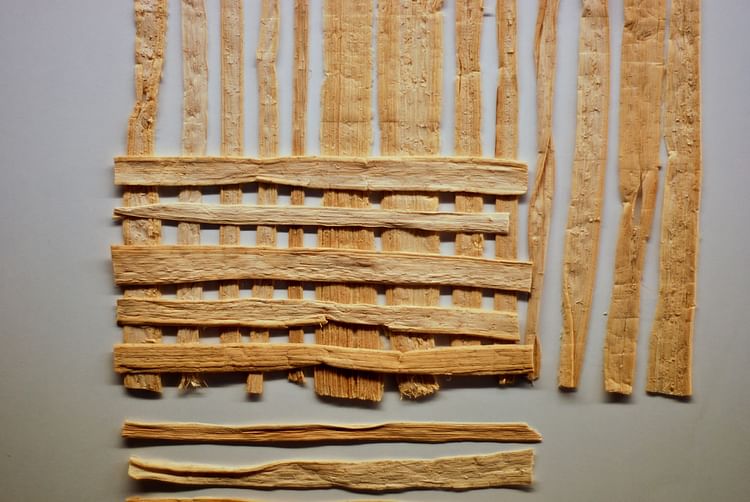
Papyrus is a plant ( cyperus papyrus ) which once grew in abundance, primarily in the wilds of the Egyptian Delta but also elsewhere in the Nile River Valley, but is now quite rare. Papyrus buds opened from a horizontal root growing in shallow fresh water and the deeply saturated Delta mud. Stalks reached up to 16 feet tall (5 m) ending in small brown flowers which often bore fruit. These plants once were simply part of the natural vegetation of the region, but once people found a utilitarian purpose for them, they were cultivated and managed in farms, harvested heavily, and their supply depleted. Papyrus still exists in Egypt today but in greatly reduced number.
The papyrus of Egypt is most closely associated with writing - in fact, the English word 'paper' comes from the word 'papyrus' - but the Egyptians found many uses for the plant other than a writing surface for documents and texts. Papyrus was used as a food source, to make rope, for sandals, for boxes and baskets and mats, as window shades, material for toys such as dolls, as amulets to ward off throat diseases, and even to make small fishing boats. It also played a part in religious devotion as it was often bound together to form the symbol of the ankh and offered to the gods as a gift. Papyrus also served as a political symbol through its use in the Sma-Tawy, the insignia of the unity of Upper and Lower Egypt. This symbol is a bouquet of papyrus (associated with the Delta of Lower Egypt) bound with a lotus (the symbol of Upper Egypt).
BESIDES WRITING, PAPYRUS WAS USED AS A FOOD SOURCE, TO MAKE ROPE, FOR SANDALS, AS WINDOW SHADES, MATERIAL FOR TOYS SUCH AS DOLLS, AS AMULETS TO WARD OFF THROAT DISEASES, & EVEN TO MAKE SMALL FISHING BOATS.
The plant may also be seen etched in stone on temples and monuments, symbolizing life and eternity as the Egyptian afterlife, known as the Field of Reeds, was thought to mirror the fertile Nile River Valley right down to the abundance of papyrus. The name 'Field of Reeds' actually refers to the reeds of the papyrus plant. At the same time, however, the papyrus thicket represented the unknown and the forces of chaos. Kings are regularly depicted hunting in the papyrus fields of the Delta to symbolize the imposition of order over chaos.
The dark and mysterious nature of the papyrus fields were frequently employed as a motif in mythology. Papyrus fields feature in a number of important myths; most notably that of Osiris and Isis after Osiris is murdered by his brother Set and Isis hides their child Horus in the marshes of the Delta. The papyrus reeds, in this case, hid the mother and child from Set's intentions to kill Horus and so again symbolize order prevailing over disorder and light over darkness.
NAME & PROCESSING
Papyrus is the Greek name for the plant and may come from the Egyptian word papuro (also given as pa-per-aa ) meaning 'the royal' or 'that of the pharaoh ' because the central government had control of papyrus processing as they owned the land and, later, oversaw the farms the plant grew on. The ancient Egyptians called the plant djet or tjufi or wadj, forms of the concept of freshness. Wadj further denotes lushness, flourishing, greenness. Once papyrus was cut, harvested, and processed into rolls, it was called djema which may mean 'clean' or 'open' in reference to the fresh writing surface.
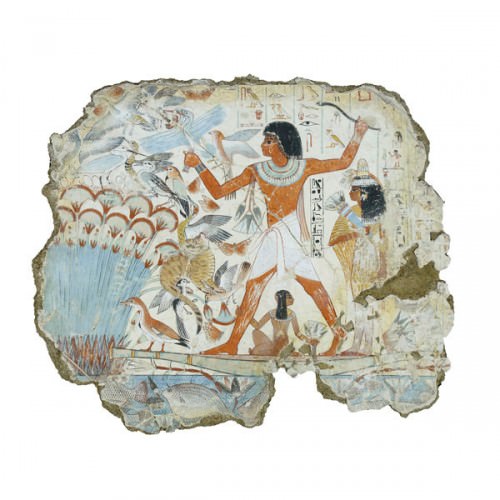
Nebamun Hunting in the Marshes
Papyrus was harvested from the beginning of the Predynastic Period in Egypt (c. 6000-c.3150 BCE) and continued to be throughout Egypt's history down to the Ptolemaic Dynasty (323-30 BCE) and into Roman Egypt (30 BCE - c. 640 CE). Field workers would harvest the plants from the marsh by cutting them at the bottom with sharp blades, bundling the stalks together, and carrying them to some conveyance which brought them to a processing center. Historian Margaret Bunson describes the process whereby the plants were made into workable sheets:
The stem of the papyrus plant was cut into thin strips which were laid side by side in perpendicular fashion. A solution of resin from the plant was laid down and a second layer of papyrus was put into place, horizontally. The two layers were then pressed and allowed to dry. Immense rolls of papyrus could be made by joining the single sheets...The sides of a papyrus where the fibers run horizontally are the recto and, where the fibers run vertically, the verso. The recto was preferred but the verso was used for documents as well, allowing two separate texts to be included on a single papyrus. (201)
Egyptologist Rosalie David adds to the description, detailing the stages of this process of forming the plants into sheets:
In the first stage, the stalk of the plant was sliced into pieces and the pith was cut out and beaten with a hammer to produce wafers. These were arranged side by side and crosswise in two layers and were then beaten into sheets. Then the individual pages were stuck together in the same way to form a standard roll of twenty pages;sometimes the rolls were stuck together as required to provide an even longer writing surface. After drying in the sun the full strip was rolled up with the horizontal fibers on the inside. This was the "recto" that would be written on first. (200)
The sheets, now joined into rolls, were then transported to temples, government buildings, the market or exported in trade.Although papyrus is closely associated with writing in general, it was actually mostly used only for religious and government texts because manufacturing costs were fairly expensive. Not only was the manual labor in the fields and marshes costly, it took skilled workers to methodically beat and process the plant without destroying it. All of the extant papyri are from temples, government offices, or personal collections of wealthy or at least well-off individuals. Written works often appear on pieces of wood, stone, or ostraca (shards from clay pots). The image of the Egyptian scribe hunched over his papyrus scroll is accurate, but long before he got his hands on that scroll, he would have spent literally years practicing writing on potsherds, chunks of stone, and pieces of wood.
USES & EXAMPLES
The scribes of ancient Egypt spent years learning their craft and, even if they were from wealthy families, they still were not allowed to waste precious material on their lessons. David notes that "the most common and cheapest writing materials were ostraca and pieces of wood. These were often used by schoolboys for their letters and exercises" (200). Only once one had mastered the basics of writing was one allowed to practice on a papyrus scroll. David notes how exercises found practiced on ostraca are sometimes duplicated on papyrus, which often supplies missing words or phrases to works which are incomplete in either form.
As a writing material, papyrus was used for hymns, religious texts, spiritual admonitions, letters, official documents, proclamations, love poems, medical texts, scientific or technical manuals, record-keeping, magical treatises, and literature.Extant scrolls range from fragments to one page to the famous Ebers Papyrus which is 110 pages long on a scroll sixty-five feet (20 metres) long. The Ebers Papyrus is a medical text which is routinely cited as evidence of how medicine and magic were interrelated in ancient Egypt. Along with other papyrus scrolls like the Kahun Gynaecological Papyrus, the London Medical Papyrus, and the Edwin Smith Papyrus, to name only a few, these works attest to the vast medical knowledge and skill of the ancient Egyptians and how they went about addressing major and minor injuries, various ailments, and serious conditions such as cancer and heart disease. Cases of anxiety, depression, and trauma are also dealt with in the medical texts of Egypt as are subjects like abortion, birth control, menstrual cramps, and infertility.
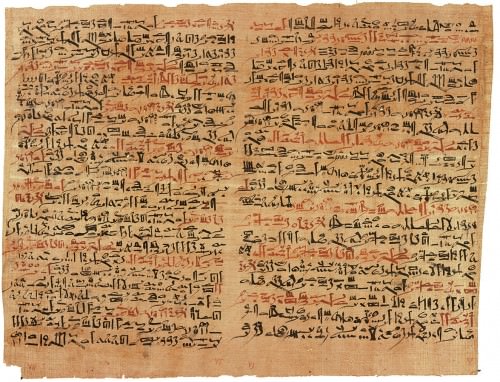
Edwin Smith Papyrus
Papyrus was also, of course, used for literary texts. The term 'literature' is commonly applied to an array of ancient Egyptian works from medical texts, royal decrees and proclamations, letters, autobiographies and biographies, religious texts, and others besides works of the imagination. A number of these works were inscribed in tombs, on temple walls, or on stele and obelisks while those which fit the common definition of 'literature' were written on papyrus. Some of the best known are The Tale of the Shipwrecked Sailor, The Report of Wenamun, and The Tale of Sinuhe, but there are many others.
Ancient Egyptian scribes wrote in black and red ink. Red was used for the names of demons or evil spirits, to mark the beginning of a new paragraph, for emphasis of a word or passage, and for punctuation in some cases. Scribes carried a wooden case which held cakes of black and red paint and a water flask to mix and dilute the paint into ink. The pen was initially a thin reed with a soft tip but was replaced in the third century BCE by the stylus, a more robust reed sharpened to a very fine point. A scribe would begin a work on the recto of the papyrus roll, write until it was filled, and then flip it over to continue the text on the verso. In some instances, a papyrus roll on which only the recto had been used would be taken by another scribe and used for another work, either complementary or completely unrelated.
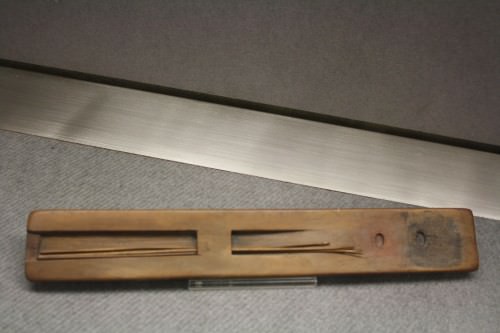
Egpytian Scribe's Palette
As noted, however, papyrus was not used exclusively for writing. The plant could be baked and eaten, and Herodotus reports that the papyrus root was a staple of the Egyptian diet. It was cut and prepared in a variety of dishes much as the later potato came to be in other cultures. Papyrus was not only a food source but leaned itself to an incredibly diverse range of uses. The earliest Egyptian skiffs were made by tightly weaving stalks of papyrus and binding them with rope, also made of papyrus. This technique created a light-weight water-tight boat which could easily be carried by hunters or fishermen. The papyrus skiff is featured in numerous tomb and temple paintings and has a markedly different, more linear, shape than later wooden boats built on the same design. Papyrus continued to be a significant aspect of the Egyptian boat even after wood replaced it as the primary material. When small wooden vessels were developed into large sailing ships, the plant was woven into ropes for the sails. Papyrus rope, however, was used for a number of purposes besides sailing and papyrus fiber, which was quite strong, proved useful in other products.
Mats and window shades were woven through a technique similar to that used to make writing material. The shafts of the plant were set down vertically and then woven with others horizontally and pulled tightly; they were then bound with a thinner fiber from the plant. Sandals were made by coiling the papyrus and were so sturdy that many examples of them have been found thousands of years after they were made still in good condition. Papyrus sandals required a great deal of skill to make and were too expensive for most people. Herodotus reports that the priests of Amun only wore papyrus sandals which, along with other evidence, scholars interpret as further proof of the priests' great wealth. Dolls or other toy figures were made by bunching up the stalks and then shaping them through tightly tied fibers to create a head, arms, and legs.
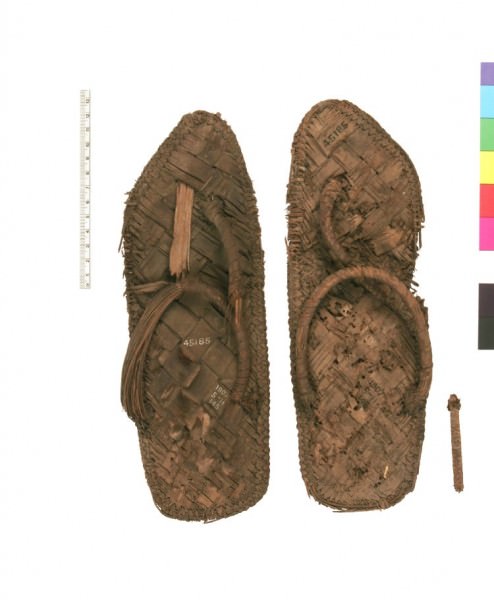
Papyrus Sandals
This "bunching" of the plant was employed in the creation of a popular offering to the gods: the shape of the ankh. The ankh, symbol of life and promise of life everlasting, was one of the most important icons of ancient Egypt and frequently placed with offering to the gods at temples or obelisks. Egyptologist Richard H. Wilkinson notes how "the ankh could be symbolized by floral bouquets and the 'papyrus swathe' (bundles of flowers and plant foliage tied around a central bunch of papyrus stalks) which was commonly offered to the gods" (161). This same technique was used in creating the Sma-Tawy symbol representing the unity of the country. The association of papyrus with unity and the gods is fitting in that the plant, like the gods and the gifts of the land, was an integral part of the people's lives.
Ehecatl › Who Was?
Definition and Origins
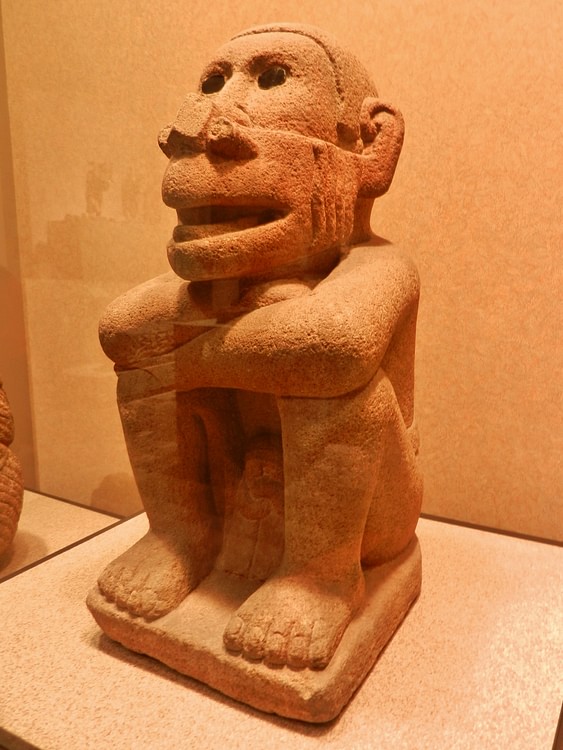
Ehecatl was a Mesoamerican god of air and winds, especially those which brought rains. Regarded as a manifestation of the great feathered serpent god Quetzalcoatl, he was sometimes known as Quetzalcoatl-Ehecatl, in which guise he helped create humanity in the Aztec creation myth and gave the gift of the maguey plant. He was also associated with the cardinal directions, colours, and several calendar dates.
NAME & ASSOCIATIONS
Ehecatl means 'wind' in nahuatl. Possibly of Huastec origin, who built many circular or curved temples in his honour, he was adopted by the Aztecs, who thought he was born from flint on the day 9 Wind, which was his other name. They also named the 2nd day in the Aztec calendar after him. Ehecatl acquired various associations besides the wind in general, amongst them the calendar dates 6 Ehecatl the sun, 7 Ehecatl the day humanity was created, and 9 Ehecatl the winds from the four quarters. He is the patron of the second trecena (a time period of the calendar) 1 Jaguar.
As the god was regarded as a manifestation or wind aspect of the feathered serpent god Quetzalcoatl, one of the most important deities in the Mesoamerican pantheon, he is sometimes referred to as Quetzalcoatl-Ehecatl. Thus, two more dates carry his name: 1 Ehecatl Iztac Tezcatlipoca ('White' Tezcatlipoca being the equivalent of Quetzalcoatl) and 4 Ehecatl Xolotl (Xolotl being Quetzalcoatl's twin). Quetzalcoatl-Ehecatl was also one of the four sky-bearing deities, specifically in the direction west. Ehecatl was regarded as the patron of merchants and was associated with spider monkeys, perhaps because of their great speed.
IN POSTCLASSIC SCULPTURE AND CODICES, EHECATL WEARS A CONICAL HAT AND DUCKBILL MASK.
CREATION MYTHOLOGY
Ehecatl features in the Aztec Creation mythology, first, as the 2nd sun of the cosmos Nahui Ehecatl, and then during the creation of the present world with the 5th and final sun. According to one version of the myth, Quetzalcoatl took on the guise of Ehecatl and descended into the Underworld where he stole the bones of the inhabitants of the former worlds in order to create humans in this one. Mictlantecuhtli, the god of the Underworld, was none too happy about people popping into his realm whenever they felt like it and so would only let Ehecatl go free if he could somehow get music from a conch shell. Ehecatl cleverly had worms bore holes in it and bees buzz inside it to produce a tremendous sound, thus ensuring his liberty.
Ehecatl also helped in the movement of the 5th sun and moon. These had been created when the twin brothers Nanahuatzin and Tecuciztecatl had thrown themselves into a sacrificial fire. The problem, though, was that neither celestial body could move and so Ehecatl, in one version at least, was called upon to blow them into their respective orbits.
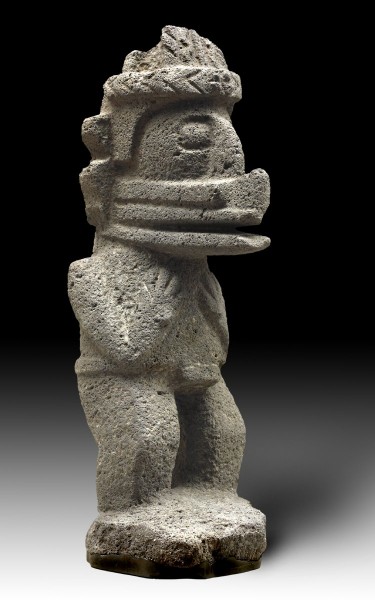
Ehecatl
EHECATL & MAYAHUEL
Ehecatl is sometimes credited with giving the important maguey plant ( Agave americana ) to humanity. This type of cactus was useful for its spines and its juice was fermented into the alcoholic drink pulque. The story begins with Ehecatl persuading Mayahuel, a beautiful young goddess, to descend from the heavens and become his lover. Down on earth, the two embraced as a pair of intertwining trees but their raptures were soon rudely interrupted by Tzitzmitl, the 'grandmother' goddess, who was Mayahuel's guardian. The elderly goddess split the tree in two and fed the pieces to her demon followers, the Tzitzimime.Ehecatl, being a more powerful god, was unharmed in this episode, and so he gathered what pieces of Mayahuel he could find and planted them in a field. These remains then grew into the maguey plant. Two other gifts to humanity besides pulque which are often credited to Ehecatl are music and maize.
TEMPLES
The Mesoamerican temples dedicated to Ehecatl and other wind gods are distinctive in that they are circular as opposed to the usual square pyramid, or they incorporate a curved end. The roof of such buildings was typically conical too. This design may reflect the desire to make them aerodynamically welcoming for the winds of the god they honour. The doorways are usually formed as the jaws of a giant snake. This may well be in imitation of the caves Mesoamerican peoples considered entrances to the Underworld where the winds were thought to originate from.
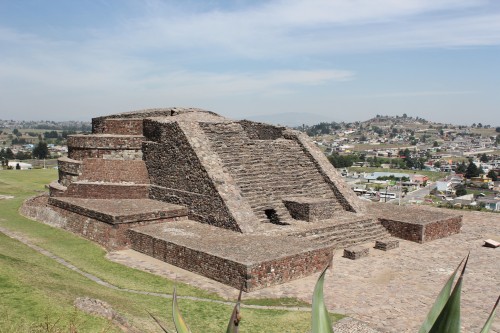
Temple of Ehecatl, Calixtlahuaca
REPRESENTATION IN ART
There are no known representations of the god prior to the 12th century CE, although two stelae from Maya Seibal, dating to the 9th century CE, depict a god with a beak-like face. Ehecatl is most frequently portrayed in Postclassic sculpture and codices, wearing a conical hat and duckbill mask or buccal (although sometimes the corners of the bill have fangs, a common feature of rain gods) which covers the lower part of his face. If coloured, then his body is painted black and his facemask red.He sometimes wears shells, especially the conch shell ( ehecacozcatl or 'wind jewel'), worn as a pectoral, with which he whistled his way out of the Underworld. Shells may be another clue as to the god's coastal Huastec origins. One of the most famous statues of the god is from a temple dedicated to Quetzalcoatl-Ehecatl at Calixtlahuaca in the Toluca Valley. The god stands 1.76 m tall, rigid and ready to blow his divine winds through his beak mask. It is now on display in the National Museum of Anthropology in Mexico City.
Cortes & the Fall of the Aztec Empire › Antique Origins
Ancient Civilizations
The Aztec empire flourished between c. 1345 and 1521 CE and dominated ancient Mesoamerica. This young and warlike nation was highly successful in spreading its reach and gaining fabulous wealth, but then all too quickly came the strange visitors from another world. Led by Hernan Cortés, the Spaniard's formidable firearms and thirst for treasure would bring devastating destruction and disease. The Conquistadores immediately found willing local allies only too eager to help topple the brutal Aztec regime and free themselves from the burden of tribute and the necessity of feeding the insatiable Aztec appetite for sacrificial victims, and so within three years fell the largest ever empire in North and Central America.
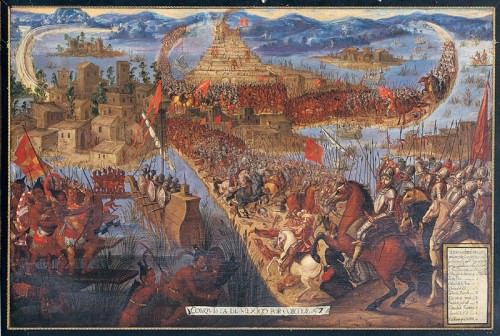
Cortes & the Siege of Tenochtitlan
THE AZTEC EMPIRE
By around 1400 CE several small empires had formed in the Valley of Mexico and dominant amongst these were Texcoco, capital of the Acholhua region, and Azcapotzalco, capital of the Tepenec. These two empires came face to face in 1428 CE with the Tepanec War. The Azcapotzalco forces were defeated by an alliance of Texcoco, Tenochtitlan (the capital of the Mexica) and several other smaller cities. Following victory, a Triple Alliance was formed between Texcoco, Tenochtitlan, and a rebel Tepanec city, Tlacopan. A campaign of territorial expansion began, where the spoils of war - usually in the form of tributes from the conquered - were shared between these three great cities. Over time Tenochtitlan came to dominate the Alliance, its leader became the supreme ruler - the huey tlatoque ('high king') - and the city established itself as the capital of the Aztec Empire.
The empire continued to expand from 1430 CE, and the Aztec military - bolstered by conscription of all adult males, men supplied from allied and conquered states, and such elite groups as the Eagle and Jaguar warriors - swept aside their rivals.Battles were concentrated in or around major cities, and when these fell, the victors claimed the whole surrounding territory.Regular tributes were extracted, and captives were taken back to Tenochtitlan for ritual sacrifice. In this way, the Aztec empire came to cover most of northern Mexico, an area of some 135,000 square kilometres with a population of around 11 million. As the chronicler Diego Duran put it, the Aztecs were "Masters of the world, their empire so wide and abundant that they had conquered all the nations." (Nichols, 451)
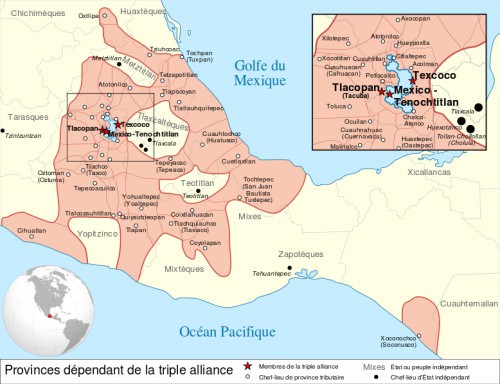
Aztec Empire
The empire was loosely kept together through the appointment of officials from the Aztec heartland, inter-marriages, gift-giving, invitations to important ceremonies, the building of monuments and artworks which promoted Aztec imperial ideology, imposition of the Aztec religion (especially worship of Huitzilopochtli ), and most importantly of all, the ever-present threat of military intervention. This meant that it was not a homogenous and mature empire where its members had a mutual interest in its preservation. Some states were integrated more than others whilst those on the extremities of the empire were exploited merely as buffer zones against more hostile neighbours. In addition, the Aztecs were heavily defeated by the Tlaxcala and Huexotzingo in 1515 CE. One neighbouring power in particular, a constant thorn in the Aztec flank, was the Tarascan civilization. Endlessly troublesome, they, the Tlaxcalans and others, would prove to be vital allies for the Spaniards when they came to plunder and conquer the vast riches of Mesoamerica. Fighting for their independence from Aztec rule they did not realise that they would merely be replacing one rapacious overlord for another even more destructive one.
By 1515 CE rumours in the Aztec heartlands and several bad omens of a rapidly approaching crisis were fuelled by sightings off the coast of fantastic floating temples. The visitors from the Old World had finally come.
HERNAN CORTÉS & THE CONQUISTADORES
The Spanish Governor of Cuba, Diego Velasquez, had already sent several expeditions to explore the mainland coast of America starting in 1517 CE, and these had reported strange ancient stone monuments and brightly dressed natives from whom were bartered fine gold objects. Ironically, one group of natives had actually been sent by the Aztec king Motecuhzoma II Xocoyotzin ( Montezuma ) to see for themselves who these mysterious bearded men were, but a lack of a common language meant the Spanish returned to Cuba unaware they had missed an opportunity to finally prove there was a large civilization and source of treasure beyond the coast. Velasquez was convinced enough by the gold objects, though. The governor organised another expedition and chose as its leader Hernan Cortés. In his fleet of 11 ships went 500 soldiers and 100 sailors, all of them adventurers and treasure-seekers.
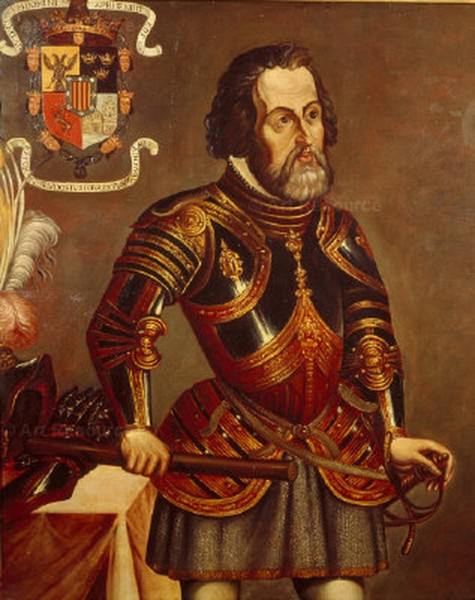
Hernan Cortes
Cortés, a native of Extremadura, had studied law at university, but at 19 years old he had decided to leave Spain and try his luck in the Caribbean colonies. After running a plantation and participating in the conquest of Cuba, he was now in his mid-30s and ready for his stab at fame and glory. Perhaps not only out for gold, Cortés was a deeply religious man, and the spirit of evangelism, for him if not his followers, was an extra motivation to open up this New World.
Landing on the Tabasco coast at Potonchan, Cortés immediately met hostilities, but the Europeans easily subdued the natives with their superior weapons and tactics. As a gift of reconciliation Cortés was presented with some slave girls, and one of these, a certain Malintzin (aka Marina or Malinche), would prove an invaluable asset as she spoke both the local Mayan language and, crucially, also the Nahuatl language of the Aztecs. One of Cortés' men spoke the former so that now the way was open to parley with any representatives the invaders came across. Malintzin would remain at Cortés' side throughout the campaign, and together they would have a son, Don Martin.
Cortés was directed to sail north, and this he did, landing near the town of Cempoala where he came across two Aztec tax collectors extracting the king's tribute from the locals. Word soon reached Motecuhzoma that a large force of violent men was confidently approaching the Aztec heartlands.
FACING THE ENEMY - MONTEZUMA
Motecuhzoma, after consulting his council of elders, decided on a strategy of diplomacy. He sent gifts to the Spanish, which included ceremonial costumes, a massive gold disk representing the sun, and an even bigger silver one representing the moon. These were gratefully received and likely made the Spanish even more interested in plundering the land for all it was worth. Ignoring instructions to return to Cuba, Cortés instead sent a shipload of the treasures they had so far acquired and letters requesting royal support to Charles V of Spain. Then a garrison was established at Veracruz on the coast. Cortés next burned all of his ships to remind his men that in the following months of hardship it was to be conquest or death. In August 1519 CE, Cortés marched directly to Tenochtitlan.
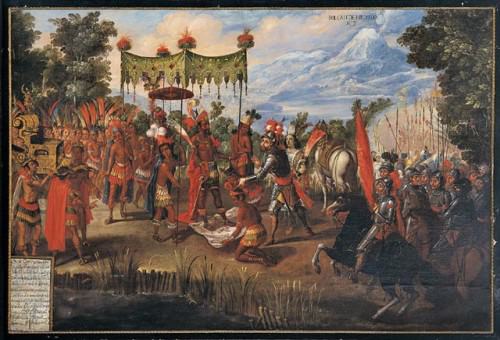
Montezuma Meets Cortes
The capital was located on the western shore of Lake Texcoco and boasted at least 200,000 inhabitants making it the largest city in the Pre-Columbian Americas. It was a huge trading centre with goods flowing in and out, such as gold, turquoise, foodstuffs, and slaves. The Spanish invaders, allowed to freely enter the city, were hugely impressed by its splendour, its magnificent architecture and artwork, its wonderful gardens, artificial lakes, and flowers. Cortés was eager to meet the Aztec king Motecuhzoma. Taking the position of tlatoani, meaning 'speaker' in 1502 CE, he ruled as an absolute monarch and was considered a god by his people and a manifestation and perpetuator of the sun. Initially, relations were friendly and valuable gifts were exchanged between the two leaders. Cortés received a necklace of golden crabs, and Motecuhzoma a necklace of Venetian glass strung on gold thread and scented with musk.
The history of the conflict about to unfold is much debated amongst scholars, and it is unlikely that the Spanish chroniclers presented a completely impartial account of events. It has been noted that it does seem strange that such a powerful ruler as Motecuhzoma should cut such a passive figure in the record of events brought down to us. However, against that it is certainly true that the Spanish had already shown their military prowess and the devastating effectiveness of their superior weaponry - cannons, firearms and crossbows - in quickly defeating a force of Otomi-Tlaxcalan, and they had also taken quick and ruthless reprisals against a treacherous plot by the Cholollan. Perhaps Motecuhzoma had taken note of this and took the more prudent policy of appeasement rather than engage the enemy in the field, at least as an opening strategy. This seems a more reasonable explanation than the traditional view, now rejected by modern historians as a post-conquest rationalising fiction, that Motecuhzoma reverently believed that Cortés was the returning god Quetzalcoatl of Aztec mythology.
AFTER AN INITIAL AIR OF CORDIALITY BETWEEN THE TWO SIDES, THINGS SOON TURNED SOUR WHEN CORTÉS AUDACIOUSLY TOOK MONTEZUMA HOSTAGE.
Whatever the reasons, the initial air of cordiality between the two sides soon turned sour for within two weeks the Aztec ruler was audaciously taken hostage and placed under house arrest by the small Spanish force. Motecuhzoma was forced to declare himself a subject of Charles V, handover more treasure and even allow the placing of a crucifix on top of the Great Pyramid or Templo Mayor in the city's sacred precinct.
THE FALL OF TENOCHTITLAN
The crisis deepened when Cortés was forced to return to Veracruz and face a new force sent from Cuba to arrest him for disobeying his orders to return to Cuba. Some of the remaining Spanish, commanded by Pedro de Alvarado, were then killed at Tenochtitlan after they tried to interrupt a ceremony of human sacrifice. This incident was just what Cortés needed, and after battling the Cuban relief force at Veracruz and persuading its leader Panfilo Narvaez to join his cause, he returned to the city to relieve the besieged remaining Spanish. The Aztec warrior commanders, unhappy at Motecuhzoma's passivity, overthrew him and set Cuitlahuac as the new tlatoani. The Spanish tried to have Motecuhzoma calm the populace, but he was struck in the head by a thrown rock and killed. Some think the Spanish strangled him in secret as he was clearly of no use to either side any longer.
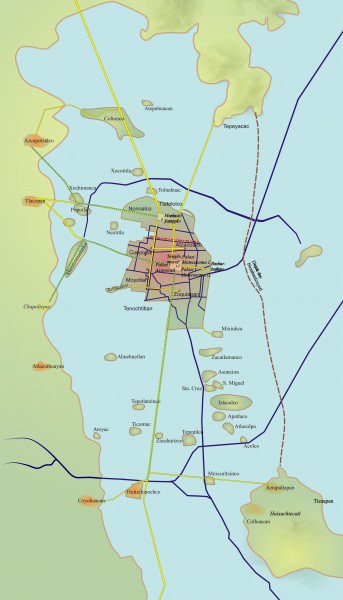
Tenochtitlan
Holed up in the royal palace, Cortés resisted several waves of attacks and then fought to control the gigantic Templo Mayor pyramid, which was being used as a handy vantage point to rain down missiles on the Spanish. A fierce battle ended in Cortés taking control of the temple, which he then set fire to, horrifying the population. Cortés grabbed what booty he could and fled the city in a running night battle on the 30th of June, 1520 CE, in what became known as the Noche Triste (Sad Night).
Gathering local allies from his Tlaxcala base, and now supported by Texcoco, Cortés first won a great battle near Otumba and then returned to Tenochtitlan ten months later, laying siege to the city with a fleet of specially built warships. With these ships, Cortés was able to block the three main causeways which linked the city to the edge of Lake Texcoco. Lacking food and ravaged by smallpox disease earlier introduced by one of the Spaniards, the Aztecs, now led by Cuauhtemoc, finally collapsed after 93 days of resistance on the fateful day of 13th of August, 1521 CE. Tenochtitlan was sacked and its monuments destroyed. The Tlaxcalans were ruthless in their revenge and slaughtered men, women, and children wholesale, even shocking the hardened Spanish veterans with their atrocities. From the ashes of this disaster rose the new capital of the colony of New Spain, and Cortés was made its first governor in May 1523 CE.
CONQUERING THE EMPIRE
With the fall of Tenochtitlan, the Spanish set about pacifying the rest of the empire and discovering what other treasures could be plundered. In this, they were helped enormously by two factors. The first was help from disgruntled subject peoples or traditional enemies of the Aztecs. On the march to Tenochtitlan, Cortés had already enlisted the enthusiastic help of the Tlaxcalans, both in men and supplies. With the collapse of the Aztec hierarchy, other local communities were only too willing to see the back of them and free themselves from heavy tribute and the systematic capture of people to be sacrificed at the Aztec capital.
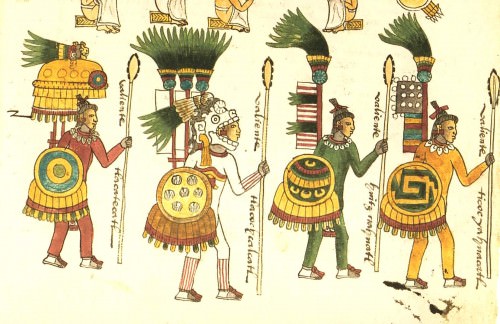
Aztec Warriors
The second factor in the Spaniard's favour was the primitive weaponry and ritualised warfare of their opponents. Aztec warriors wore padded cotton armour, carried a wooden or reed shield covered in hide, and wielded weapons such as a super sharp obsidian sword-club ( macuahuitl ), a spear or dart thrower ( atlatl ), and bow and arrows. Effective though these were against even more poorly equipped native Americans, they were next to useless against the Spanish guns, crossbows, steel swords, long pikes, cannons, and armour.
Cavalry was another devastating weapon in the hands of the Europeans. Elite Aztec warriors and officers also wore spectacular feathered and animal skin costumes and headdresses to signify their rank. This made them highly conspicuous in battle and a prime target to dispatch as early as possible. Shorn of their commanders, the Aztec units often disintegrated into panic. The Aztecs were used to loose formations in battle; their primary objective had always been to capture a valiant opponent alive so that they might be later ritually sacrificed, and warfare was highly ritualised with precise moments for starting and ending. The objective of Aztec warfare was never to destroy completely the enemy and overturn their culture, while the Spanish were intent on exactly that. The two sides were not just centuries but millennia apart in terms of arms technology and warfare tactics.
There could only be one winner, and within three years Mesoamerica, including the Tarascan capital of Tzintzuntzan and the Maya highlands, were under Spanish control. Gradually, Franciscan friars arrived to spread Christianity, and the bureaucrats took over from the adventurers. In 1535 CE, Don Antonio de Mendoza was made the first viceroy of the kingdom of New Spain.
CONCLUSION
Montezuma seems to have had some instinct that troubled times were ahead as he gave great importance to omens such as a comet sighted in 1509 CE, and he constantly consulted soothsayers for advice. Aztec mythology foretold that the present era of the 5th sun would eventually fall just as the previous four eras had done, and so it came to pass. The Aztec empire collapsed, its temples were defaced or destroyed, and its fine art melted down into coins. Ordinary people suffered from the European-introduced diseases which wiped out up to 50% of the population, and their new overlords did not turn out to be any better than the Aztecs. Systematically and ruthlessly, the culture of the ancient Mesoamericans, a heritage going back millennia, was repressed and where possible eradicated in an effort to install the new order of the Old World. Unfortunately, with the continued extraction of tribute both in goods and forced labour, this new order was no less brutal and unforgiving than the old one.
LICENSE:
Article based on information obtained from these sources:with permission from the Website Ancient History Encyclopedia
Content is available under License Creative Commons: Attribution-NonCommercial-ShareAlike 3.0 Unported. CC-BY-NC-SA License